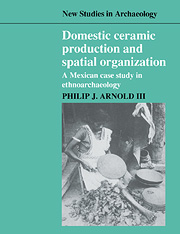Book contents
- Frontmatter
- Contents
- List of figures
- List of tables
- Acknowledgements
- 1 Introduction
- Part 1 Ceramic production and consumption in Los Tuxtlas
- Part 2 Ceramic production and spatial organization
- 5 Archaeological approaches to ceramic production
- 6 Spatial organization and ceramic production
- 7 Disposal patterns within production houselots
- Part 3 Application and implication
- References
- Index
6 - Spatial organization and ceramic production
Published online by Cambridge University Press: 02 December 2009
- Frontmatter
- Contents
- List of figures
- List of tables
- Acknowledgements
- 1 Introduction
- Part 1 Ceramic production and consumption in Los Tuxtlas
- Part 2 Ceramic production and spatial organization
- 5 Archaeological approaches to ceramic production
- 6 Spatial organization and ceramic production
- 7 Disposal patterns within production houselots
- Part 3 Application and implication
- References
- Index
Summary
The relationship between production activities and material residue is neither simple nor self-evident. Linking the two requires research conducted in a contemporary setting. These connections cannot be established directly from the archaeological evidence; those material patterns are the very phenomena we are attempting to decipher. Analyses of production decisions, and their material implications, must be established through research that controls for both behavior and the material record.
At the same time, archaeologists cannot simply rely on ethnographic anecdotes and interpretations through analogy. As noted previously, there is a distinction between learning by experience and learning from experience. The discussion in Chapter 5 suggested that inordinate emphasis has gone toward the former. This section considers how pottery making within Los Tuxtlas may assist with the latter.
This chapter explores ways to link variability in the organization of ceramic production with the material patterns of manufacturing activities. The emphasis on both the material technology and behavioral components of production allows the archaeologist to begin considering the potential contribution of these factors to the archaeological consequences of production. This perspective represents a first step toward developing a middle-range theory of ceramic manufacture.
This discussion makes the point that the material technology associated with a given production system can be as much a function of internal conditions as external variability. In addition to such considerations as the natural environment and/or market demand, the potter must also select production techniques that are suited to the specific characteristics of the context of manufacture.
- Type
- Chapter
- Information
- Domestic Ceramic Production and Spatial OrganizationA Mexican Case Study in Ethnoarchaeology, pp. 99 - 119Publisher: Cambridge University PressPrint publication year: 1991

